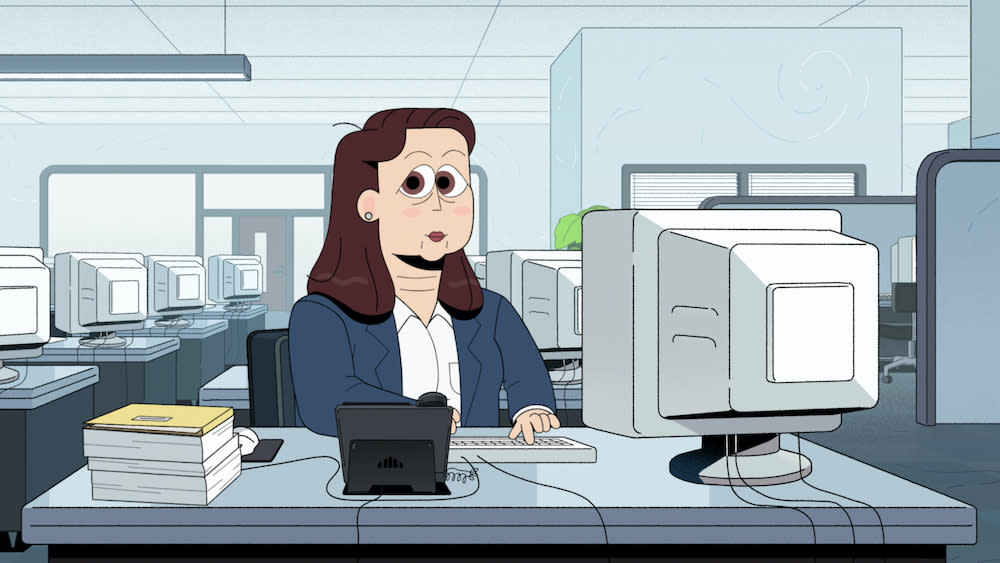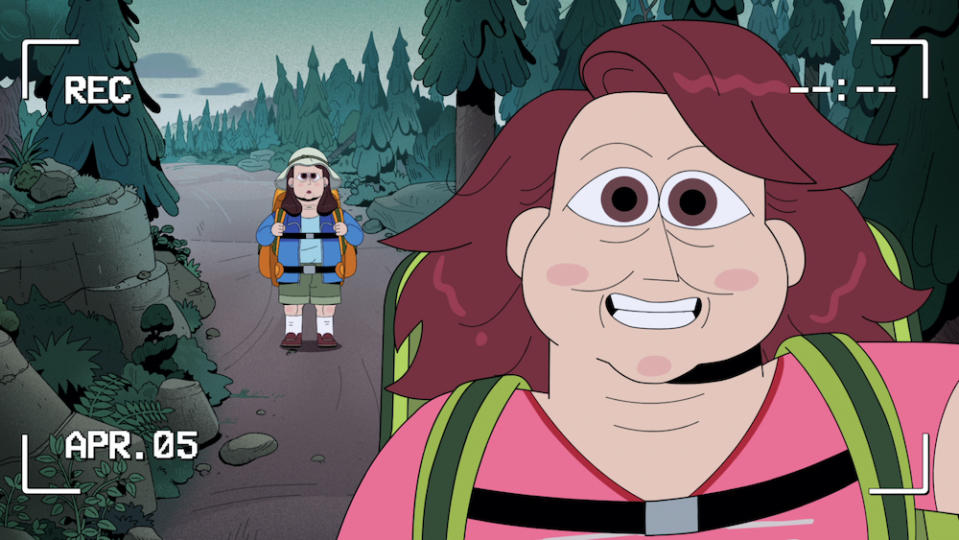‘Carol and the End of the World’ Is a Poignant, Creative Plea to Rebuild Society — Before It’s Too Late

- Oops!Something went wrong.Please try again later.
Carol Kohl is sitting on a train. No, she isn’t waiting for Dom Cobb to take her far away, but she is waiting for… something. Her watch is ticking, even though it doesn’t have any hands. The train isn’t moving. She’s completely alone. In an adjacent car, Carol (voiced by Martha Kelly) can see a horde of happy commuters staring back at her. A couple clad in suits of seaweed clink champagne flutes. A scuba diver swims through the air, between balloons floating like jellyfish. A bride raises her glass to toast Carol from across the tracks.
But Carol can only watch, and sit, and wait. Suddenly, her conductor chimes in to say this train is no longer in service. It powers down. The lights go out. The doors open. When Carol gets up to leave, she sees another version of herself sitting by the door. “You smell that?” the second Carol asks the first. Gas fills the car. Carol starts choking. And then she’s awake, sitting up in her bed, gasping for air. When she lays back down, the moon in the window outside is dwarfed by a giant green planet, ominously close to our own. All Carol’s done is exchange one fatal reality for another. One lonely place for another. One ending for another. Unless…
More from IndieWire
Life as depicted in “Carol and The End of the World” isn’t far removed from a dream. There may not be flying swimmers or mermaids on a train, but there’s a mile-long line of hikers waiting to summit Mount Everest and soldiers subbing for cashiers at the grocery checkout. The world is ending, and with only a matter of months left before that swirling green planet outside Carol’s window crashes into Earth, everything is a little nutty. People are doing whatever they damn well please while they’re still alive to be pleased by it. But Carol doesn’t know what to do. She doesn’t have a bucket list. She’s not into skydiving or paragliding, like her sister. She doesn’t know what she wants, just that she doesn’t want what everyone else tells her she should.
Is happiness that’s big and flashy more valuable than that which seems small and straightforward? Are simple dreams worth dreaming? Are they worth the fear of going unfulfilled?
Created by Dan Guterman, “Carol and The End of the World” plays out like an inversion of your typical apocalypse scenarios. Rather than race around the world looking for love or salvation, Carol’s journey is largely internal. She scales a mountain of self-doubt, swims the cold rivers of isolation, and finds the courage to… go into the office every day. The 10-episode limited series carries a simple message — that in the end, all we have is each other — but it infuses the oft-forgotten platitude with beguiling creative flourishes while forcing us to examine how separated, secluded, and lonely our society has already become. Whether you choose to see The End of the World as an allegory for COVID, the climate crisis, or any other existential threat facing the modern populace, Carol’s odyssey to living her best life proves jarringly effective.
And affecting. For a series that motivates viewers to reconnect with their chosen family, their friends, their community at large, it’s wise enough to root its story in characters. One character, really. Carol starts off as a somewhat passive observer. When she can’t sleep, she watches TV and sees everyone abandoning their old lives in search of something greater. Her parents (Beth Grant and Lawrence Pressman) do the same, shedding their clothes and shacking up with their home health care worker. Her sister, Elena (Bridget Everett), is jet-setting around the world, sending videos of her adventures back to the family.
But Carol isn’t interested in any of that. There’s no long-lost-love she’s put off seeking out, no skill or activity she’s been meaning to master. She actively flees a clingy one-night-stand and lies to her parents about taking up surfing, just so they won’t worry about what she’s really doing, which is a whole lot of nothing.

Until, that is, she spots a woman waiting on a train. Dressed in a skirt-suit that wouldn’t seem out of place in normal times, but seems distinguished and purposeful in light of the chaos brought on by the end of the world, the graying professional boards her morning train like it’s just another workday. Intrigued, Carol follows her and discovers, on the 19th floor of an otherwise vacant building, an operating office space. A man makes copies while sipping coffee. A woman fills out a spreadsheet in her cubicle. Papers move from the inbox to the outbox.
How could this be? Who would choose to work when the world is about to end? When money is meaningless and careers are a thing of the past? “Carol and The End of the World” provides answers to these questions, though not in the way you may expect after the pilot’s teasing office reveal. The ensuing episodes can come across oddly supportive of capitalism — of corporate office culture, at least — but it’s clear by the end what the office really means to Carol and her co-workers, and Guterman pulls no punches in how he frames management’s mentality. (A jolt of anger coursed through my veins upon hearing an executive complain about “time theft.”)
Each episode offers its own surprises. Carol’s overarching plot moves steadily forward, but how it’s told and who tells it changes from one half-hour entry to the next. Some perspectives feel extraneous and all-too-ordinary for such an imaginative 10-episode limited series. (Sorry to this man, but I do not care about Eric.) For the most part, though, Guterman builds a compassionate portrait of a nightmare scenario through rich, unique characters. One of Carol’s closest office-mates, Donna (Kimberly Hebert Gregory), gets an incredible Christmas episode, and her sister, Elena, provides the perfect lens for an unexpected sisterly bonding passage.
The series also uses silence so, so well. Whether it’s Carol settling into her admin role at the office or her various explorations of the city around her, the animation (produced by Bardel Entertainment) fills the frame with information. The uniformity of the office is realized by rows of computer monitors, overhead lights, even plain white coffee mugs, all lined up in meticulous sameness. Outside, however, Carol could be chased by a pack of dogs while riding her company “car” (it’s actually a motorcyle) or she may stumble into a teenage orgy inside an old Office Depot. Order and routine become a comfort, but it doesn’t take long for Carol to need more than that; to need more than security; to seek out connection and instill a little chaos of her own (which, of course, is barely a whisper of the tumult seen elsewhere).
With tremendous voice work by “Baskets” star Martha Kelly, “Carol and The End of the World” is a beguiling spin on existential dread, surreptitiously celebrating nonconformist thinking in presentation and spirit, even as it plops down our out-of-place leads within a beacon of convention. It encourages everyone to take a minute and think about what’s really missing in our post-pandemic, end-stage-capitalism society. It may be a life partner, it may be a career to be proud of, it may be a trip around the world. Or it may just be a weekly happy hour at Applebee’s.
Grade: B+
“Carol and The End of the World” premieres Friday, December 15 on Netflix.
Best of IndieWire
Sign up for Indiewire's Newsletter. For the latest news, follow us on Facebook, Twitter, and Instagram.

